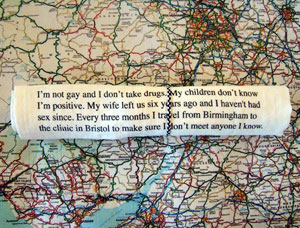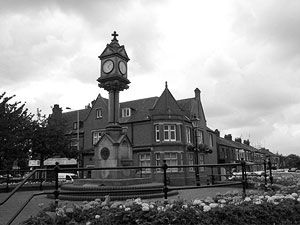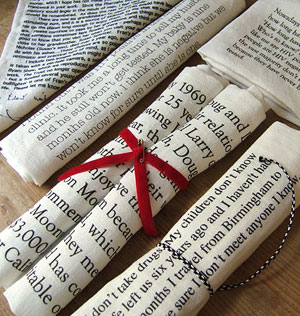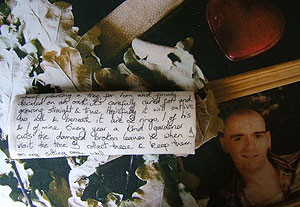HIV and making Table Talk
Susie Freeman

In 2004 I was awarded an Arts Council grant for Slim – a study of HIV in the UK. With additional research by Dr Liz Lee and support from the charity Crusaid, we developed a large installation in the form of a table setting.
“Making Table Talk was particularly challenging. Unlike previous work which was based on our own personal and professional experiences, we knew little about HIV. Starting from a relatively small knowledge base we set about trying to learn what it is like to be HIV positive today and to compare this to the experience of having HIV in the earlier phases of the epidemic.
Our first lesson was that HIV affects a whole spectrum of ordinary people. The only significant difference between patients in the waiting room of the HIV clinic and patients in a GP surgery is that there are less old people in the HIV clinic. The second lesson was that HIV remains predominantly a hidden or secret condition. The rising number of HIV positive people go unnoticed because they choose to keep their diagnosis quite private. Initially this made it difficult to gather information, but gradually we were able to find people willing to talk about their personal experiences”
Liz Lee
A table is set for guests, all of whom will have either been HIV positive or personally affected by the disease. These are all people that as a result of our research we felt we would like to meet. Each guest has a place at the table, marked by a mat and napkin; the images and writing on these reflecting something of each personal story. They also have a place-card with first name only, year of birth and sometimes year of death.
The history of the HIV pandemic is also the history of its drug treatment. These medications form a central table runner showing chronologically the development of retrovirals as well as an indication of treatments for opportunistic infections.
I interviewed people who are HIV positive along with relatives, friends and carers of others who had died of AIDS. Liz met with professionals working in the field, following their work in clinics and talking to patients.

Our illustrated guests include a haemophiliac, a pregnant woman, a Terrance Higgins Trust buddy volunteer and David Carr, who died in his mid-twenties in 1957 following a complex medical condition which mystified doctors during his five month stay in Manchester Royal Infirmary. Known as the Manchester Sailor, David Carr was the earliest known confirmed case of HIV in the UK at the time we made Table Talk. Tissue samples preserved from his death were subsequently tested from 1983 to 1987 revealing he had HIV infection. It is now thought that HIV existed for hundreds of years but remained undiagnosed.
The youngest person included is Susan, a twelve year who is not yet fully aware of her diagnosis. When she visits the GP surgery a sign flashes up on the computer screen to alert and remind the doctor to her HIV positivity.

The napkins on the table are printed with the stories of the guests, but most of these are exhibited rolled and tied, concealing some of the information just as the diagnoses are kept private. Four people agreed to have their full interviews on display, and these napkins are laid out so the whole story is visible. In Susan’s case, the account comes from one of her carers:
I work as a nurse specialising in the care of children who are HIV positive. Because of the social stigma associated with HIV and because the public still have a real problem with it, you can’t tell very young children their diagnosis because they might blurt it out…
Click here to read the rest of Susan’s story
In 2007 for the exhibition Medical Mesh in Bergen, we expanded the installation to include 2 people living in Norway. We continue to collect information and welcome opportunities to broaden the piece for other countries.
We would like to thank all those who contributed their experiences and assisted with our research.
